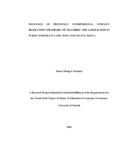| dc.description.abstract | The purpose of this study was to investigate the influence of principals’ interpersonal conflict resolution strategies on teachers’ job satisfaction in public secondary schools in Lamu West Sub County, Kenya. The objectives of the study were; to determine the extent to which principals’ use of avoiding strategy influences teachers’ level of job satisfaction, to determine the extent to which principals’ use of forcing strategy influence teachers’ level of job satisfaction, to establish the extent to which principals’ use smoothing strategy and how it influences teachers’ level of job satisfaction, to establish the extent to which principals use of compromising strategy influence teachers’ level of job satisfaction and to establish the extent to which principals use confronting strategy and how it influence teachers’ level of job satisfaction. The study employed a descriptive survey design. The target population was 11 schools out of 17 public schools, 11 principals out of 17 principals in public schools which is about 64.71 percent and 88 teachers out of 212 which is about 41.51 percent in Lamu West Sub County. Simple random sampling was used and 10 percent was picked from the total population. To ascertain reliability, the test re-test technique was employed by the researcher where questionnaires were administered to two principals and six teachers from two schools. The researchers then revisited the school after two weeks for a second re-administration. The results from the two test administered were analyzed using Pearson’s product moment correlation coefficient. Data for the study was collected by the researcher using questionnaires and was analyzed according to descriptive information following the research questions. Descriptive statistical analysis was employed and it enabled the researcher to reduce, summarize, organize, evaluate and interpret the numeric information. The findings of the study were presented using tables, frequencies and percentages. Different principals used different strategies to solve conflict which in turn influenced teachers’ job satisfaction. Most principals used forcing and confronting strategies both at 33.3 percent, followed by avoiding, smoothing and compromising strategies all at 11.1 percent respectively. Most teachers were in opinion that 46 percent of principals use smoothing strategy, 20 percent confronting, 18 percent forcing, 11 compromising and 5 percent avoiding strategy. The study concluded that most principals used smoothing, forcing and confronting resolution strategies to influence teachers’ job satisfaction leading to job satisfaction or dissatisfaction while avoiding strategy was the least preferred conflict resolution strategy. The study also suggested that this study should be replicated in other public secondary schools in other counties in Kenya. A study should be carried out to investigate the influence of teachers’ interpersonal conflict resolution strategies on students’ performance and also find out the effects of various conflict resolution strategies used by various schools on the academic performance of students. | en_US |

